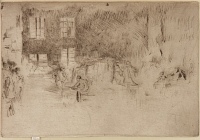Etchings Institutions search term: wunderlich
Murano - Glass Furnace | ||
| Number: | 205 | |
| Date: | 1879/1880 | |
| Medium: | drypoint | |
| Size: | 161 x 238 mm | |
| Signed: | no | |
| Inscribed: | no | |
| Set/Publication: | no | |
| No. of States: | 4 | |
| Known impressions: | 7 | |
| Catalogues: | K.217; M.214; W.187 | |
| Impressions taken from this plate (7) | ||
KEYWORD
TITLE
'Murano - Glass Furnace' (1883, Fine Art Society). 1
'Murano - Glass Furnace' (1886, Frederick Wedmore (1844-1921)). 2
'Murano Glass Furnace' (1889, Whistler). 3
'Murano - Glass blowers. Venice' (1890/1892, Beatrice Whistler (1857-1896)). 4
'Murano Glass Works' (1903/1935, possibly Rosalind Birnie Philip (1873-1958)). 5
'Glass-Furnace, Murano' (1909, Howard Mansfield (1849-1938)). 6
The original title, 'Murano - Glass Furnace' is preferred, although Beatrice Whistler's version, specifying the actual workers, is an interesting alternative.
1: London FAS 1883 (cat. no.1).
2: Wedmore 1886 A (cat. no. 187).
3: Whistler to Dowdeswell, 16 February 1889, GUW #13031.
4: List, GUW #12715.
5: Envelope containing the copper plate, University of Glasgow
6: Mansfield 1909 (cat. no. 214).
DESCRIPTION
SITE
Whistler apparently loved the subject but did not particularly like the glass. When he received a crystal flower from Robert de Montesquiou-Fezensac (1855-1921), he wrote:
7: Grieve 2000 , pp.72, 175.
(Translated: 'No! those glasses are no longer made in Murano! - It is three centuries since they forgot the joyous simplicity, the light solemnity, and the flight of imagination necessary to produce the little masterpiece which you send us from Paris').
8: [January 1890], GUW #04123.
DISCUSSION
9: Study for 'The Little Forge' (K.147) [m0574], Sketch of 'The Whitesmiths, Impasse des Carmélites' [m1417], Sketches of 'The Forge: Passage du Dragon' and 'The Smith: Passage du Dragon' [m1450], r.: The Blacksmith's, Howth; v.: Horse in a stable [m1619], r.: The Forge; v.: Smiths, Ajaccio [m1679], The Flaming Forge, Ajaccio [m1678].

